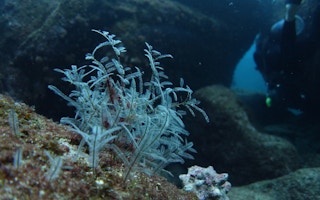The Great Barrier Reef has become a major issue in the federal election campaign, with the stakes raised by the most severe bleaching ever documented and suggestions that the next few years will be our last chance to avert major damage to this World Heritage-listed icon.
Last week, Prime Minister Malcolm Turnbull and federal environment minister Greg Hunt announced a further commitment of up to A$1 billion over ten years, from an existing A$10 billion “special account” administered by the Clean Energy Finance Corporation.
Turnbull said that this new Reef Fund will provide loans to finance more energy- and water-efficient irrigation systems on farms, as well as improved pesticide and fertiliser application systems. He also raised the possibility of the fund being used to finance solar panels on farms, saying:
The Reef Fund will support clean energy projects in the Reef catchment. It will finance solar panels and other renewable energy substitutes on farms as well as more energy efficient equipment in agriculture, local government and tourism.
The government says that this financing will be on top of A$461 million already pledged for the Great Barrier Reef, currently planned to be spent on incentive programs to help farmers move to more “water quality friendly” management practices as has been happening over the past seven years.
Labor, for its part, has pledged A$500 million over five years – including A$123 million as a continuation of an existing Coalition pledge – to be split between scientific research, pollution reduction and restoration projects, and reef management.
Is this enough money?
We already have relatively robust estimates of the funds needed to bring the reef’s water quality into line with the government’s official water quality guidelines set by Great Barrier Reef Marine Park Authority in 2010. Unfortunately, we also know it will cost much more than either major party has pledged so far.
One estimate (on which I worked) puts the cost at between A$5 billion and A$10 billion over ten years. These amounts are far in excess of the current spending trajectory, based on what has already been spent: just under half a billion dollars on farming and water-quality management, as outlined above.
This funding has achieved some limited success in reducing pollution on the Great Barrier Reef. But it is now clear that much more funding and regulation will be needed to meet the required water quality guidelines.
How much money have the parties pledged?
Financial commitments, both in government budgets and election pledges, are difficult to assess accurately. Funding can be committed across several budgets, and it is important to distinguish between no-strings funding and loan financing.
Here is a breakdown of what the three leading parties are promising to deliver.
The Coalition will spend A$450 million over 6 years (from various programs including Reef Trust and Reef Plan) or about A$350 million over 5 years (from this July) plus the new A$1 billion loan facility, which will be portioned out over 10 years.
Labor has made a A$500-million, five-year commitment, albeit contingent on maintaining A$123 million of funding previously pledged by the Coalition, with A$377 million representing newly pledged funds.
Labor’s half-billion-dollar total can be broken down into A$377 million of direct, on-ground spending plus other current ongoing budget funding. The other roughly A$130 million is designated for research and organisational management.
The Greens have pledged A$500 million in new funding, to be spent on improved farming practices and other land restoration projects, plus a A$1.2-billion loan facility to help farmers transition to low-pollution farming methods. Both schemes would be administered over five years.
The Greens have also promised to retain A$370 million in existing funding for water-quality projects, which it says brings its total financial plan for the reef to more than A$2 billion.
The Greens have also promised to use the law to protect the reef, by using the powers of the GBR Marine Park Act of 1975 to regulate polluting activities in the reef’s nearby river catchments. Tightening these regulations could help to reduce pollution faster, potentially reducing the amount of money needed to hit the reef’s pollution targets.
The Queensland government has also allocated A$90 million to spend on direct water quality improvement measures over the next few years. It will also use its regulatory powers under the state’s Great Barrier Reef Protection Amendment Act of 2009 to improve the region’s farming practices.
Loans and profits
One large question hanging over the the Coalition and Greens’ loan pledges is whether farmers will be keen to accept this financing, even at “low” interest rates. As many farmers are currently unwilling even to accept grant money to improve practices which provide them with little financial benefit, it is difficult to foresee a wide takeup of a loan facility.
Many environmentally beneficial changes to farm practice bring no net profit for the farmers themselves. Farming lobby group Canegrowers has questioned whether this is the best approach, arguing that the industry would rather receive dollar-matching grants than loans.
The Clean Energy Finance Corporation (CEFC) is currently providing loans via the major banks to allow farmers to invest in energy-efficient equipment, with interest rates discounted by up to 70 basis points relative to commercial rates. This would be the model that would most likely be followed for the new proposal.
Future loans doled out under the Coalition’s A$1 billion fund would need to remain within the CEFC’s broad investment mandate of funding projects and technologies that reduce greenhouse emissions. Thus, more efficient fertiliser use, higher-efficiency irrigation pumps, and low-till cropping would all fit the bill.
It is unclear, however, whether other farming improvements that could benefit the reef – such as gully stabilisation or repair – would be judged to come under the mandate of the CEFC loans, or whether they might be excluded.
Regardless, the proposed loan program will still not put nearly enough funds into what is a pressing issue, and a parallel system of focused grants for individual pollution-reduction projects would seem to us to be a sensible approach.
Without stronger regulation (which only the Greens are suggesting) and considerably more funding than any of the main parties is yet willing to provide – not to mention stronger action on emissions reductions throughout the economy – none of these policies promises a particularly rosy future for the Great Barrier Reef.
Jon Brodie is chief research scientist, Centre for Tropical Water & Aquatic Ecosystem Research, James Cook University. David Rickards is managing director of Social Enterprise Finance Australia. This article was originally published on The Conversation.











